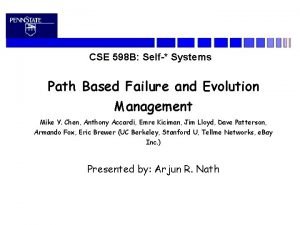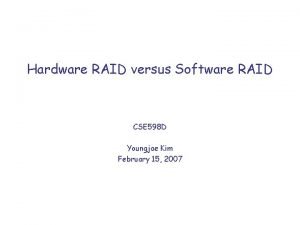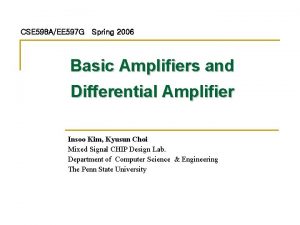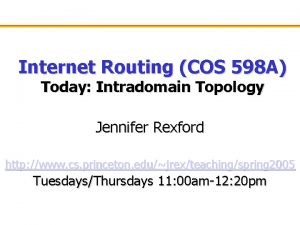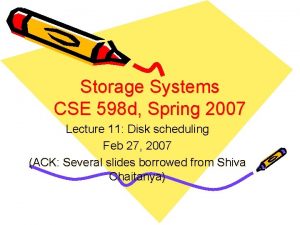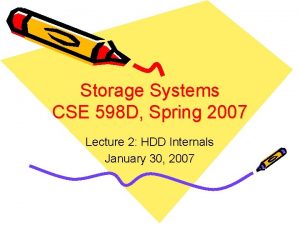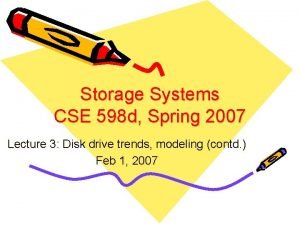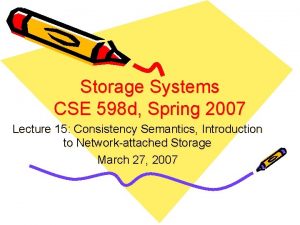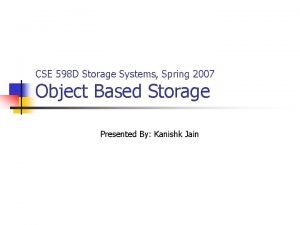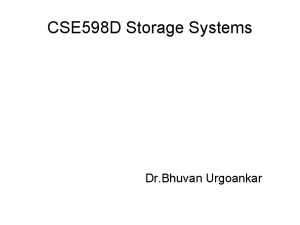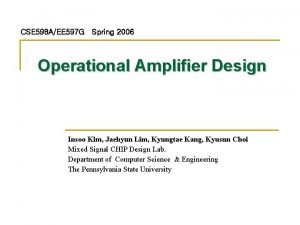Storage Systems CSE 598 d Spring 2007 Lecture












- Slides: 12

Storage Systems CSE 598 d, Spring 2007 Lecture ? : Rules of thumb in data engineering Paper by Jim Gray and Prashant Shenoy Feb 15, 2007

Contents • Examination of rules-of-thumb in data engineering – Moore’s law – Amdahl’s rules – Gilder’s law • Technological trends and how/whether existing rules-of-thumb need to be re-thought

Moore’s Law • Circuit densities grow at 4 x every 3 years – 100 x increase in a decade – More generally: Ax every B years – Originally meant for RAM • Implies an extra bit of addressing every 18 months • From 16 -bit of addressing in 70 s (1 MB) to 64 bit addressing these days (several GB) – Extended to CPU and storage

Disk parameters over time

Moore’s law applied to HDD • Disk capacity has increased more than 100 x in the last decade! – Areal density up from 20 Mbpsi to 35 Gbpsi • However, data rate has only increased 30 x – Capacity / Accesses per sec growing 10 x per decade – Capacity / bandwidth growing 10 x per decade • Implications: – Disk accesses becoming more precious – Disk data becoming “cooler”

Closer look at the implications • Discussion – Does the increase in disk capacity mean applications are also using correspondingly large stores? – Why are disk accesses per second going up? • Recall these have grown slower than areal density • 10 years ago: 30 kaps for 1 GB data • Today: 120 kaps for 80 GB data – That is, only 1. 5 kaps per GB – HDD data needs to be 10 -100 x cooler than it was 10 years ago – Use large main memories (caching)

Costly disk accesses have led to. . • Preferring few large transfers over many small ones • Preferring sequential transfers – Log-structured file systems • Mirroring rather than other forms of redundancy

Cost trends • Historically – Tape: HDD: RAM has been 1: 1000 • Calculation for a modern system gives 1: 3: 300 – Disk prices are approaching tape prices • Disks are replacing tapes in several domains – Cost/MB for RAM declines 100 x in a decade • What is economical to put on disk today may be economical to put on RAM in 10 years – RAM taking up lot of the role of the HDD, HDD taking up a lot of the role of tape • Storage management costs exceed device costs • Admins required to manage more and more data – Automation, self-manageability becoming crucial

Amhdal’s System Balance Rules • Parallelism law – Expresses maximum achievable speedup in terms of the fraction of parallelizable component of a computation • Balanced system law – A system needs 1 bit of IO/sec per instruction/sec • IOPS = IPS • Memory law – MB/MIPS ratio in a balanced system is 1 • IO law – Programs do IO per 50000 instructions • How have these rules changed over time?

• Methodology – Rely on well-regarded benchmarks TPC-C (random) and TPC-H (sequential) • Revisions to Amhdal’s laws – Balanced system law: Measure instruction rate and IO rate on relevant workload – Memory law: MB to MIPS ratio rising from 1 to 4 • Re-iteration of the growth in RAM as disk IOs become expensive – IO law: Workload dependent • 50000 instructions per IO was geared toward random IO • Increased sequentiality (discussed earlier) in disk accesses means higher instructions per IO

Gilder’s Law • Network bandwidth would triple every year for the next 25 years (prediction in 1995) • Link bandwidth triples every four years • Network messages used to cost more instructions and IO instructions per byte than disk – Network protocol processing overheads – These overheads have been reduced due to smarter NICs • Cost comparison – Cost of moving data over WAN much more expensive than from local disk over LAN • Related: Cost of shipping large disk arrays or entire computers comparable to the cost of data transfer over the Internet – However, this price gap likely to decline soon and bandwidth would be plentiful within a decade • Implication: Local disks could then be used as caches (or prefetch buffers) with the main data store being remote – Save on local storage management costs – Managed data center model - is already seen!

Caching • 5 minute rule for random workloads • 1 minute rule for sequential worloads • Web caches – Cache everything!
 Cse 598 advanced software analysis and design
Cse 598 advanced software analysis and design Raid 0 software vs hardware
Raid 0 software vs hardware Cse 598
Cse 598 Pipeline adc ppt
Pipeline adc ppt Hundred thousand place
Hundred thousand place Round the following numbers to the nearest hundreds 625
Round the following numbers to the nearest hundreds 625 Evaluate the postfix expression 6523+8*+3+*
Evaluate the postfix expression 6523+8*+3+* 598 kpc
598 kpc Ixp 598
Ixp 598 The heavenly banquet
The heavenly banquet 01:640:244 lecture notes - lecture 15: plat, idah, farad
01:640:244 lecture notes - lecture 15: plat, idah, farad Giduk
Giduk Winter is white spring is green
Winter is white spring is green
